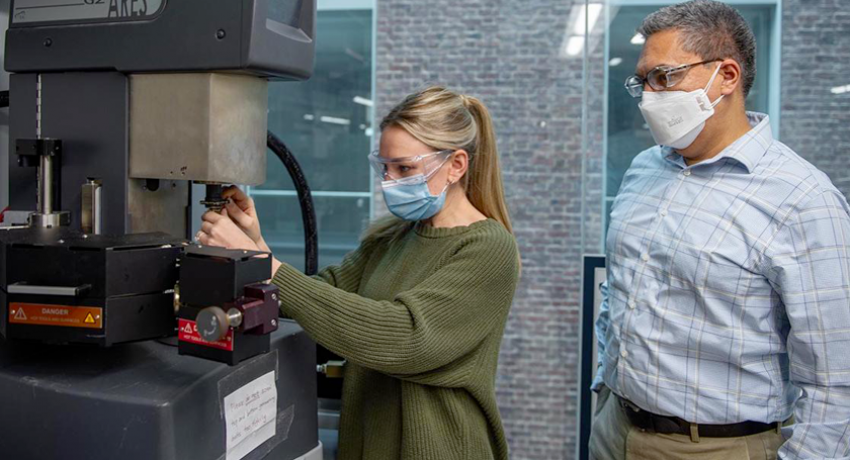Abigail Fenton (left), first author and Penn State doctoral student in chemical engineering, adjusts an ARES G2 rheometer, manufactured by TA Instruments, to measure the mechanical stiffness of a polymer sample. Co-author Enrique Gomez, Penn State professor of chemical engineering and of materials science and engineering, looks on. Credit: Kelby Hochreither/Penn State. All Rights Reserved.
Process can accelerate development of wearable technology, researchers say
By Mariah Chuprinski
An international collaboration led by Penn State researchers has developed a new tool to reduce the time and resources involved in determining which materials can be best applied in wearable technology, including biomedical devices.
The tool, reported in ACS Central Science, uses the chemical structure of a class of plastics called conjugated polymers to predict their physical properties, like stiffness or pliability. Conjugated polymers, or chains of molecules arranged on a backbone of alternating chemical bonds, have similar electrical properties as the metal and silicon used in many current wearable electronics, but are more flexible and could make for more comfortable or integrated technology, according to the researchers.
“Mechanical characteristics are important when it comes to conjugated polymers,” said Abigail Fenton, first author on the paper and Penn State doctoral student in chemical engineering. “Computer programs in materials research can be complex, and what we have made is simpler: we just plug the numbers in an equation and get information back, which tells us how brittle or flexible a material would be if we did it experimentally.”
The tool is a simple pencil-and-paper equation, according to Fenton, with two variables indicating the local chain rigidity scale, or Kuhn length, and the volume of the chain on that scale, or the Kuhn monomer volume. Together they describe the polymer’s modulus, which tells researchers how rigid or soft material manufactured from the polymer would be.
“Computers used to be in a room by themselves,” said co-corresponding author Enrique Gomez, Penn State professor of chemical engineering and of materials science and engineering. “Then, they were at home or at the office in a certain room. But now, electronics are coming closer and closer to the body with wearable technology, and it’s important to make them comfortable. We don’t want rigid devices made of hard metal; we want soft, flexible devices that are more compatible with the body.”
To determine the modulus, the researchers used a rheometer, which measures how a material responds to mechanical stress, to record the mechanical properties of a few conjugated polymers. They also used small-angle neutron scattering, an imaging technique that involves beaming neutrons into a material to determine its Kuhn length.
The equation also can be applied to materials used in medical devices, such as internal sutures or braces or casts, Gomez said.
“Anyone could take the chemical structure of a material they’re designing and use the equation to determine how squishy something is,” Gomez said. “For example, you need a squishy material for something like internal sutures, and something harder for a brace or a cast.”
In the future, the researchers plan to extend the model to not only be able to predict a material’s stiffness and flexibility, but also its electric conductibility.
“Our long-term goal in this research vein is to accelerate the development of materials for the marketplace for the benefit of society,” Gomez said. “Our part in that is to contribute to the design of plastic-based electronics by predicting final properties.”
Ralph Colby, Penn State professor of materials science and engineering and chemical engineering, served as a co-corresponding author. Other contributors included Renxuan Xie and Melissa P. Aplan, Penn State chemical engineering graduate students; Ryan Fair, a Penn State materials science and engineering graduate student; Youngmin Lee, a former Penn State chemical engineering postdoctoral researcher who is now a faculty member at New Mexico Institute of Mining and Technology; Michael G. Gill, a Penn State chemical engineering undergraduate researcher; Fabian Kempe and Michael Sommer, researchers at the Chemnitz University of Technology in Germany; and Chad R. Snyder, a researcher at the National Institute of Standards and Technology in Gaithersburg, Maryland.
The National Science Foundation’s Division of Materials Research funded the research.
Read the full news story here:
https://www.psu.edu/news/engineering/story/new-tool-can-predict-material-prop...

